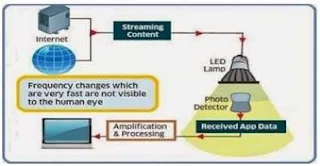Light Fidelity (Li-Fi) technology is a wireless communication system based on the use of visible light between violet (800 THz) and red (400 THz). Unlike Wi-Fi which uses the radio part of the electromagnetic spectrum, Li-Fi uses the optical spectrum i.e. Visible light part of the electromagnetic spectrum. The working of Li-Fi is very easily understood. The principle of Li-Fi is based on sending data by amplitude modulation of the light source in a well-defined and standardized way. LEDs can be switched on and off faster than the human eyes can detect the operating speed of LEDs is less than 1 microsecond. This invisible on-off activity enables data transmission using binary codes. If the LED is on, a digital ‘1’ is transmitted and if the LED is off, a digital ‘0’ is transmitted. Also, these LEDs can be switched on and off very quickly which gives us a very nice opportunity for transmitting data through LED lights, because there are no interfering light frequencies like that of the radio frequencies in Wi-Fi. Li-Fi is thought to be 80% more efficient, which means it can reach speeds of up to 1Gbps and even beyond. Li-Fi differs from fiber-optic because the Li-Fi protocol layers are suitable for wireless communication over short distances (up to 10 meters). This puts Li-Fi in a unique position of extremely fast wireless communication over short distances.
.The Li-Fi working is explained in a block diagram:


0 comments